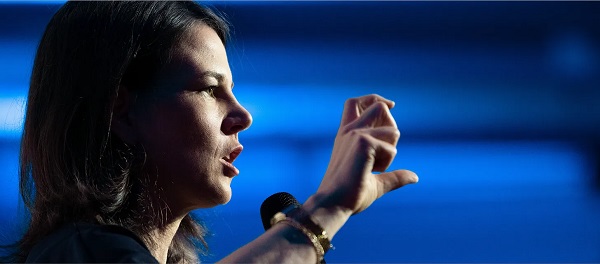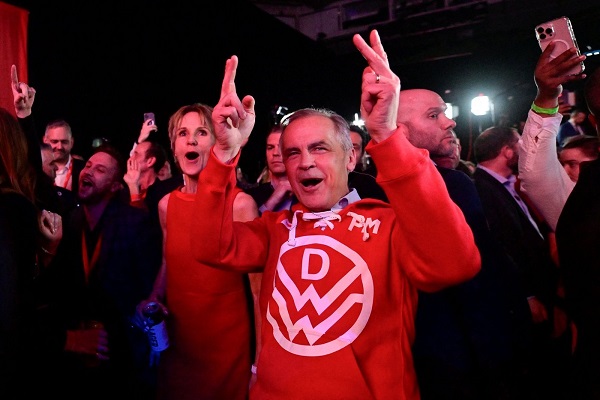International
Is Russia at War With Ukraine, or With the West?

|
German Foreign Minister Annalena Baerbock this week, on entering a “new era of nefariousness”:
I say clearly and across the Atlantic, what is right and what is wrong shall never be irrelevant to us. No one wants and no one needs peace more than the Ukrainians and Ukraine. The diplomatic efforts of the U.S. are of course important here. But such a peace must be just and lasting and not just a pause until the next attack… We will never accept a perpetrator-victim reversal. A perpetrator-victim reversal would be… the end of security for the vast majority of countries. And it would be fatal for the future of the United States.
Baerbock’s declaration that a “perpetrator-victim reversal” (a Täteropferumkehr, I’m reliably informed) would be “fatal” to the U.S. was historic. It was accompanied by a promise that “as transatlantacists,” Europeans must “stand up for our own interests, our own values, and our own security.” Although new leaders are ready to take the reins in Germany, she said, there can be no waiting for the transfer of power. Immediately, “Germany must take the lead at this historic milestone.”
A few years ago Baerbock pleaded for patience with a British conservative who demanded to know why Germany wasn’t providing Leopard tanks to Ukraine.
Now, with Donald Trump cutting off weapons deliveries and shutting down access to ATACMS missiles, Baerbock’s speech is an expression of more enthusiastic European support for continued fighting.
The war in Ukraine is often called a proxy conflict between Russia and the West or Russia and the U.S., but it increasingly looks more like a fight between Baerbock’s “transatlanticists” and those who believe in “spheres of influence.” In preparing Racket’s accompanying “Timeline: The War in Ukraine,” I found both sides articulated this idea repeatedly.
In January, 2017, as he was preparing to relinquish his seat to Mike Pence, Joe Biden alluded to the recent election of Donald Trump in a speech at Davos. Describing the “dangerous willingness to revert to political small-mindedness” of “popular movements on both the left and right,” Biden explained:
We hear these voices in the West—but the greatest threats on this front spring from the distinct illiberalism of external actors who equate their success with a fracturing of the liberal international order. We see this in Asia and the Middle East… But I will not mince words. This movement is principally led by Russia.
Biden even then lumped Trump and Putin together, as enemies of the “liberal international order.” Russian counterparts like Putin and Foreign Minister Sergei Lavrov, meanwhile, spoke of a “post-West world order” where diplomatic relations would be based on “sovereignty” and the “national interests of partners.” These are two fundamentally irreconcilable worldviews. Was conflict inevitable, or could peace have held if Russia didn’t strike in 2022?
There’s no question who invaded whom. Hostilities began in February, 2022 with an angry speech by Vladimir Putin and bombs that landed minutes later in Ukraine. Little discussion of the “why” of the war took place in the West, however.
Phrases like “unprovoked aggression” became almost mandatory in Western coverage. Politico interviewed a range of experts and concluded that what Putin wanted was “a revanchist imperialist remaking of the globe to take control of the entire former Soviet space.” This diagnosis of Putin’s invasion as part of a Hitlerian quest for Lebensraum and a broader return to national glory might have merit, but it was also conspicuously uncontested. A differing article by University of Chicago professor John Mearshimer declaring the crisis “the West’s fault” made him, as The New Statesman just put it, “the world’s most hated thinker.” Few went there after.
Russians and Ukrainians don’t have the typical profiles of ancient warring tribes. They have a deeply intertwined history, with citizens of both countries retaining many of the same customs, jokes, and home remedies, while living in the same crumbling Soviet buildings, with fondness for the same cabbage soup and moonshine. There are huge numbers of mixed/bilingual families and many famous cultural figures (including my hero Nikolai Gogol) are claimed by both countries. They’ve fought before, but what jumped out reviewing this “Timeline” is how much it seemed that these old Slavic neighbors mostly fall out now over attitudes toward the West.
It’s hard looking back not to be struck by the superior tone of bodies like the Organization for Security and Co-operation in Europe (OSCE), whose “reviews” of Ukrainian and Russian elections often read like zoological descriptions of inferior species. Same with a tsk-tsking report by a mission of visiting IMF economists in 2013, who were appalled by Ukrainian energy subsidies that were among of the few popular remnants of Soviet life.
These imperious Western assessments of childlike Slavs, and the panic and shame of some local officials before such foreign judgments, recall familiar satires in Russian literature (The Government Inspector comes to mind). Nationalists in both countries balked at this “advice,” and by the late nineties some came to the conclusion that the cost of cooperation with the West was greater than the benefit. These dynamics accelerated after the Orange Revolution in 2004 and the Maidan events of 2013-2014, which Russians still see as a West-backed coup and the beginning of the current war. Russians will say “first blood” was drawn in military operations against Donbass protesters around the same time. Those in the West will point at the 2014 annexation of Crimea as the beginning of territorial war.
The idea of Germany “taking the lead” in a war to secure the primacy of “transatlanticists” worries me more than trying to pronounce Täteropferumkehr. However, whether or not you think Baerbock is right, and a peace deal now would be a worthless “pause,” depends a lot on how you read this history. What do you think, and why?
Business
Dallas mayor invites NYers to first ‘sanctuary city from socialism’

From The Center Square
By
After the self-described socialist Zohran Mamdani won the Democratic primary for mayor in New York, Dallas Mayor Eric Johnson invited New Yorkers and others to move to Dallas.
Mamdani has vowed to implement a wide range of tax increases on corporations and property and to “shift the tax burden” to “richer and whiter neighborhoods.”
New York businesses and individuals have already been relocating to states like Texas, which has no corporate or personal income taxes.
Johnson, a Black mayor and former Democrat, switched parties to become a Republican in 2023 after opposing a city council tax hike, The Center Square reported.
“Dear Concerned New York City Resident or Business Owner: Don’t panic,” Johnson said. “Just move to Dallas, where we strongly support our police, value our partners in the business community, embrace free markets, shun excessive regulation, and protect the American Dream!”
Fortune 500 companies and others in recent years continue to relocate their headquarters to Dallas; it’s also home to the new Texas Stock Exchange (TXSE). The TXSE will provide an alternative to the New York Stock Exchange and Nasdaq and there are already more finance professionals in Texas than in New York, TXSE Group Inc. founder and CEO James Lee argues.
From 2020-2023, the Dallas-Fort Worth-Arlington MSA reported the greatest percentage of growth in the country of 34%, The Center Square reported.
Johnson on Thursday continued his invitation to New Yorkers and others living in “socialist” sanctuary cities, saying on social media, “If your city is (or is about to be) a sanctuary for criminals, mayhem, job-killing regulations, and failed socialist experiments, I have a modest invitation for you: MOVE TO DALLAS. You can call us the nation’s first official ‘Sanctuary City from Socialism.’”
“We value free enterprise, law and order, and our first responders. Common sense and the American Dream still reside here. We have all your big-city comforts and conveniences without the suffocating vice grip of government bureaucrats.”
As many Democratic-led cities joined a movement to defund their police departments, Johnson prioritized police funding and supporting law and order.
“Back in the 1800s, people moving to Texas for greater opportunities would etch ‘GTT’ for ‘Gone to Texas’ on their doors moving to the Mexican colony of Tejas,” Johnson continued, referring to Americans who moved to the Mexican colony of Tejas to acquire land grants from the Mexican government.
“If you’re a New Yorker heading to Dallas, maybe try ‘GTD’ to let fellow lovers of law and order know where you’ve gone,” Johnson said.
Modern-day GTT movers, including a large number of New Yorkers, cite high personal income taxes, high property taxes, high costs of living, high crime, and other factors as their reasons for leaving their states and moving to Texas, according to multiple reports over the last few years.
In response to Johnson’s invitation, Gov. Greg Abbott said, “Dallas is the first self-declared “Sanctuary City from Socialism. The State of Texas will provide whatever support is needed to fulfill that mission.”
The governor has already been doing this by signing pro-business bills into law and awarding Texas Enterprise Grants to businesses that relocate or expand operations in Texas, many of which are doing so in the Dallas area.
“Texas truly is the Best State for Business and stands as a model for the nation,” Abbott said. “Freedom is a magnet, and Texas offers entrepreneurs and hardworking Texans the freedom to succeed. When choosing where to relocate or expand their businesses, more innovative industry leaders recognize the competitive advantages found only in Texas. The nation’s leading CEOs continually cite our pro-growth economic policies – with no corporate income tax and no personal income tax – along with our young, skilled, diverse, and growing workforce, easy access to global markets, robust infrastructure, and predictable business-friendly regulations.”
Crime
National Health Care Fraud Takedown Results in 324 Defendants Charged in Connection with Over $14.6 Billion in Alleged Fraud

A 50-district dragnet uncovers transnational fraud, AI-driven deception, and systemic theft from Medicare, Medicaid, and U.S. taxpayers totaling over $14.6 billion
The Department of Justice announced Monday the outcome of the 2025 National Health Care Fraud Takedown, the largest coordinated enforcement action against health care fraud in U.S. history. Federal prosecutors have filed criminal charges against 324 individuals across 50 federal judicial districts and 12 State Attorneys General’s Offices, including 96 licensed medical professionals—among them doctors, nurse practitioners, and pharmacists. The defendants stand accused of orchestrating fraudulent schemes amounting to more than $14.6 billion in intended losses to Medicare, Medicaid, and other federally funded programs.

This historic enforcement action more than doubles the previous national record of $6 billion. As part of this effort, federal and state authorities have seized over $245 million in cash, luxury vehicles, cryptocurrency, and other high-value assets. The Centers for Medicare & Medicaid Services (CMS) separately reported that it successfully prevented more than $4 billion in fraudulent payments in the months leading up to the Takedown. CMS also confirmed that it suspended or revoked the billing privileges of 205 providers linked to fraudulent activity. In the civil domain, federal agencies filed actions against 20 defendants tied to $14.2 million in alleged fraud and finalized civil settlements with an additional 106 defendants, totaling $34.3 million in recovered funds.
The Takedown was led by the Health Care Fraud Unit of the DOJ Criminal Division’s Fraud Section and carried out in close coordination with U.S. Attorneys’ Offices nationwide, the Department of Health and Human Services Office of Inspector General (HHS-OIG), the Federal Bureau of Investigation (FBI), the Drug Enforcement Administration (DEA), and multiple state law enforcement agencies. Medicaid Fraud Control Units in 18 states also played a central role in investigating and prosecuting the cases.
In remarks accompanying the announcement, Secretary of Health and Human Services Robert F. Kennedy Jr. emphasized that the agency would aggressively work with law enforcement to eliminate the “pervasive health care fraud that drove up costs and harmed patients under the former administration.” Attorney General Pamela Bondi echoed the urgency, calling the action “justice delivered to those who steal from taxpayers and endanger lives.” Matthew R. Galeotti, head of the Justice Department’s Criminal Division, underscored the gravity of the crimes targeted, noting that fraudulent schemes often lead not only to financial losses but also to direct patient harm, including medically unnecessary procedures and worsened addiction outcomes.
FBI Director Kash Patel emphasized that this Takedown represents the largest in the bureau’s history, highlighting the theft of more than $13 billion from federal health programs. Acting Inspector General Juliet T. Hodgkins of HHS-OIG described the scale of harm as unprecedented and reaffirmed the agency’s commitment to safeguarding the public.
Among the most significant components of this national operation was Operation Gold Rush, which uncovered a sophisticated transnational conspiracy responsible for over $10 billion in fraudulent Medicare claims. The scheme was orchestrated by foreign nationals who, acting as a coordinated criminal enterprise, acquired more than 30 medical supply companies across the United States. These companies had already been enrolled in Medicare, and were then used to funnel false claims for urinary catheters and other durable medical equipment. Stolen identities of over one million Americans were used to submit these claims, which had not been requested by patients, nor ordered by physicians.
The conspiracy relied on straw owners sent from Russia and Estonia to the U.S., who were directed by co-conspirators communicating through encrypted channels. Using fraudulent documentation, these straw owners opened U.S. bank accounts for laundering proceeds. Though the organization submitted over $10.6 billion in claims, CMS successfully blocked most of the payments. Only approximately $41 million reached the conspirators via Medicare, but approximately $900 million was disbursed by Medicare supplemental insurers before the fraud was detected.
Four individuals were arrested in Estonia and eight others were apprehended at major U.S. airports and border crossings as they attempted to flee. Law enforcement seized approximately $27.7 million in fraud proceeds from this operation.

Federal prosecutors filed related charges in five districts: the Central District of California, the Middle District of Florida, the Northern District of Illinois, the District of New Jersey, and the Eastern District of New York.
In a separate scheme centered in Illinois, the Department brought charges against five individuals, including two executives from Pakistani marketing firms, who used artificial intelligence to generate fake audio recordings of Medicare beneficiaries purporting to consent to receive medical equipment. This fraudulent data was sold to laboratories and equipment suppliers, which used it to file $703 million in false claims. Approximately $418 million was ultimately paid out on these claims, and the government has so far seized $44.7 million in related assets. The fraud involved not only AI-based deception but also the illegal sale and laundering of stolen personal health information.
Another case exposed a billing company executive based in Pakistan and the United Arab Emirates who conspired with addiction treatment centers to submit approximately $650 million in fraudulent claims to Arizona Medicaid. Some services billed were never rendered, and others were so deficient as to provide no therapeutic value. The operation targeted vulnerable individuals, including members of Native American tribes and the homeless. Kickbacks were paid for patient referrals, and the executive used at least $25 million in illicit funds to purchase a $2.9 million home in Dubai.

The Department also charged 49 defendants in connection with over $1.17 billion in fraudulent claims tied to telemedicine and genetic testing. In one Florida case, an owner of both telemedicine and durable medical equipment companies orchestrated a $46 million scheme involving deceptive telemarketing campaigns that generated unauthorized genetic testing and equipment claims. The Department continues to prioritize cases involving telehealth-based fraud, which often exploits unwitting patients through misrepresented or manufactured consent.
Prescription opioid diversion was another central focus of the Takedown. A total of 74 defendants, including 44 licensed medical professionals, were charged across 58 criminal cases for illegally distributing more than 15 million opioid pills. One Texas pharmacy alone was responsible for over 3 million of these pills, which included highly addictive substances such as oxycodone, hydrocodone, and carisoprodol. The DEA concurrently announced 93 administrative actions to revoke licenses and registrations of pharmacies and providers implicated in the unlawful handling of controlled substances.
Other cases include a $28.7 million scheme in Tennessee involving medications falsely billed to the Federal Employees’ Compensation Fund, where prescriptions were neither authorized by physicians nor dispensed as claimed. In separate indictments filed in Washington and California, medical providers were charged with stealing fentanyl and hydrocodone intended for pediatric patients under anesthesia.
The geographic scope of the Takedown was vast. In total, 189 federal cases were filed across all 50 federal judicial districts, and 91 state-level cases were brought in 12 states by participating Attorneys General. This unprecedented coordination underscores the national impact and bipartisan support for rooting out fraud in American health care systems.
To enhance ongoing efforts, the Department also announced the establishment of a new Health Care Fraud Data Fusion Center.

This joint initiative brings together specialists from the DOJ’s Health Care Fraud Unit, HHS-OIG, FBI, and CMS to leverage cloud computing, artificial intelligence, and large-scale data analytics to detect emergent fraud patterns. The Fusion Center aligns with Executive Order 14243, “Stopping Waste, Fraud, and Abuse by Eliminating Information Silos,” which mandates interagency cooperation and data-sharing to reduce redundancy and increase efficiency in enforcement.
Principal Assistant Deputy Chief Jacob Foster, Assistant Deputy Chief Rebecca Yuan, Trial Attorney Miriam L. Glaser Dauermann, and Data Analyst Elizabeth Nolte coordinated this year’s Takedown from within the DOJ’s Health Care Fraud Unit. Prosecutors from the National Rapid Response team and regional Strike Forces in 27 districts led casework alongside U.S. Attorneys’ Offices and 18 state Medicaid Fraud Control Units. Additional support came from the Department of Labor, VA-OIG, IRS Criminal Investigation, Homeland Security Investigations, the Defense Criminal Investigative Service, the Office of Personnel Management, the United States Postal Service OIG, and numerous other federal and local agencies.
Image sources: US DOJ
-

 Alberta7 hours ago
Alberta7 hours agoAlberta Independence Seekers Take First Step: Citizen Initiative Application Approved, Notice of Initiative Petition Issued
-

 Crime6 hours ago
Crime6 hours agoNational Health Care Fraud Takedown Results in 324 Defendants Charged in Connection with Over $14.6 Billion in Alleged Fraud
-

 Health5 hours ago
Health5 hours agoRFK Jr. Unloads Disturbing Vaccine Secrets on Tucker—And Surprises Everyone on Trump
-

 Bruce Dowbiggin8 hours ago
Bruce Dowbiggin8 hours agoThe Game That Let Canadians Forgive The Liberals — Again
-

 Agriculture2 days ago
Agriculture2 days agoCanada’s supply management system is failing consumers
-

 Alberta1 day ago
Alberta1 day agoCOVID mandates protester in Canada released on bail after over 2 years in jail
-

 Crime2 days ago
Crime2 days agoProject Sleeping Giant: Inside the Chinese Mercantile Machine Linking Beijing’s Underground Banks and the Sinaloa Cartel
-

 Alberta1 day ago
Alberta1 day agoAlberta uncorks new rules for liquor and cannabis




 By
By 



